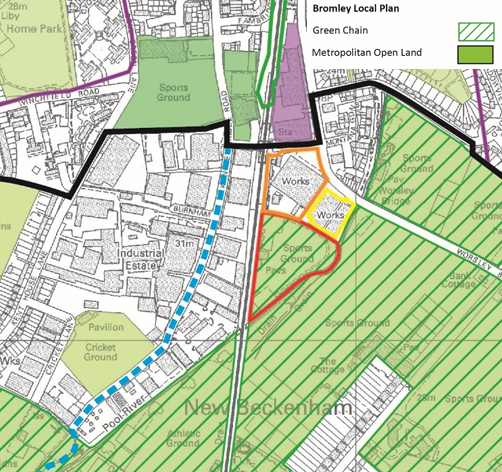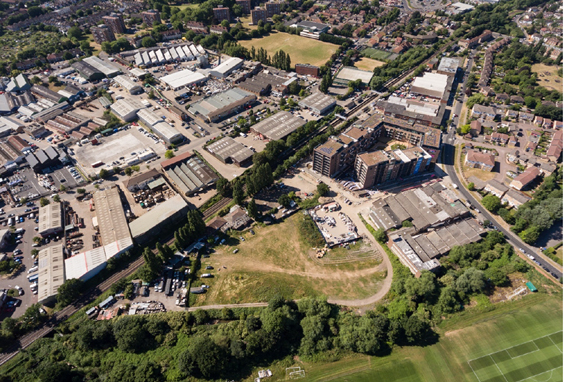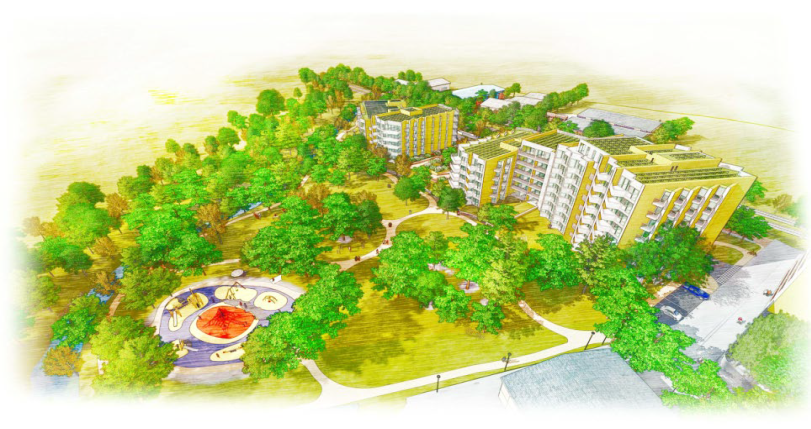Metropolitan Open Land (MOL) is a strategic planning designation, introduced by the 1976 Greater London Development Plan. Its purpose is to protect open land of significance for London as a whole, providing useful and attractive breaks in the built-up area (GLDP para 9.8). It is a different planning concept to the Green Belt (GB) but one afforded the same status and level of policy protection.
Almost one third of London is designated as either MOL or GB
[1]. Yet, in preparing the New London Plan (NLP), the Mayor of London has not reviewed London’s MOL or GB boundaries, nor is there any material change to his policies dealing with ‘inappropriate development’ proposed with the MOL or GB.
Understandably, therefore, the extent to which London has capacity to meet its identified housing and other development needs within its own boundaries, outside the MOL and GB, was a big issue at the recent NLP Examination.
There are relatively few major housing appeals in London where this tension is played out. The review of the factors that the Secretary of State or his Inspectors have found to collectively amount to Very Special Circumstances (VSC) to clearly outweigh the adjudged harm to the GB or MOL since the July 2018 NPPF, undertaken by
Planning Resource on 13 March 2019, identified just one London MOL case and that related to the QPR Football Club training centre in LB Ealing.
In the above context, the
decision on 26 June to grant planning permission on appeal for 151 homes on a MOL site adjacent to Lower Sydenham station in LB Bromley – a scheme the Inspector found to be fundamentally different to the 253 homes scheme dismissed on the same site in 2016 – is of considerable interest.
Dylon 2 Appeal Site

Lichfields annotated Bromley Local Plan and Lewisham Core Strategy Proposals Maps

Source: Aerial Photograph 2018 © Relta Ltd
The 1.86ha triangular shaped appeal site (edged red above), to which there is no public access, lies on the edge of the New Beckenham MOL.
The western edge of the site, next to the London to Hayes railway line and industrial estate beyond, contains small scale pavilion buildings and compounds for storage and vehicle parking. A track enclosing a grassed area, once a private sports pitch associated with the former industrial use of the adjoining site, lie on the eastern side of the site adjacent to the densely vegetated riverbank and large private playing fields beyond.
Immediately to the north of the site lies Crest Nicholson’s Dylon 1 development (site edged orange), comprising 223 homes in 5 to 8 storey buildings, and Bellway’s 159 homes under construction in 5 to 9 storey buildings on the Maybrey Works site (site edged yellow).
Planning Considerations
The sustainable nature of the site next to railway station providing good links to central London mainline stations was not contested.
Four of the five main issues identified by the Appeal Inspector, Mr George Baird, are pertinent to the tension between optimising housing delivery and MOL policy.
On the first issue, whether the Council could demonstrate a
5YHLS, Mr Baird found that all the recently adopted Local Plan allocations and all contested outline planning permissions to be undeliverable, as what LBB provided in its evidence and under cross examination came
“…nowhere close to the clear evidence [required by the definition of ‘deliverable’ in the revised NPPF]
to demonstrate that there is a realistic prospect that housing completions will begin on site within the relevant 5-year period” (Appeal decision, paras 9 & 18). These elements alone reduce Bromley’s supply from the claimed 5.6-years to 4.25-years, this being
“…materially below a level of undersupply that the lpa acknowledge is significant” (para 18).
On the second, the effect of the Dylon 2 scheme on the openness of the MOL, he found that:
- Spatially, the replacement of the previously developed land on 38% of the site with two (4 to 5 and 5 to 8 storey) buildings amounted to no greater building coverage and as such would have no greater impact on openness (para 20); and
- Visually, whilst the proposed buildings “would have a material impact on openness, that impact would be mitigated by the level of existing screening, its setting below the skyline and the gap between the two new buildings” (para 21).

Dylon 2 Landscape Plan, © Ian Ritchie Architects

Aerial Visualisation of Dylon 2 Scheme, © Ian Ritchie Architects
On (3), the effect of Dylon 2 on the character and appearance of the area, Mr Baird considered:
- the buildings proposed are not ‘tall buildings’, as the two blocks of varying height would not exceed the heights of the buildings in the adjacent Dylon 1 and Maybrey Works developments, nor result in a significant change to the skyline (para 24); and
- “This staggering of height combined with the separation of the buildings, the finesse of the design and detailing…combine to create a development of exceptional architectural placemaking quality that has a lightness of touch and appearance. The setting of the development along the western edge of the site, the extent of the landscaped and publicly accessible park to the east and south combined with the lighter scale and mass of the development combine to create a development that relates sympathetically to the site and MOL’’ (para 26).
Finally, the Inspector found there to be ‘other considerations’ which, collectively, clearly outweigh the substantial weight attached to the harm found due to the extent of the residential development proposed (by definition ‘inappropriate development’) and the harm adjudged to MOL openness, such that VSC exist to justify the Dylon 2 development (paras 35 – 38).
Mr Baird attached very substantial weight to the contribution made to the provision of housing and, in particular, the pressing need for affordable housing. He noted only 65 net affordable homes were completed in Bromley between 2012 & 2017, the borough’s affordability ratio is 14.26 and the only 28% of the 1,424 affordable homes needed per year is forecast within the 5YHLS (para 33). The Inspector concluded that the future position for general and affordable housing in Bromley looks bleak and Bromley’s housing requirement is “…going to increase materially” in the NLP (para 35).
He also attached very significant weight to the environmental and recreational benefits arising from the creation of a new public park, significant weight to the architectural and townscape quality of the scheme (commending the Appellant’s engagement of an architect and practice of national and international repute) and moderate weight to the economic, locational regeneration benefits of the scheme (paras 36-37).
Commentary
I consider this housing appeal success provides a useful London MOL example of the factors required to demonstrate that VSC exist. Whilst, every development proposed within the MOL or GB must be considered on its own merits, there are a number of factors in this case which I expect to have increasing resonance in London once the NLP is published in early 2020.These include (not an exhaustive list):
-
Housing Need & Shortfall: If the London housing capacity-based target increases to anywhere close to the 65,000 dpa identified in the draft NLP ( as is expected), there are likely to be a number of (mainly outer) London boroughs which will be unable to demonstrate either a 5YHLS or a plan on how to address the shortfall against the increased requirement.
-
Affordable Housing Need & Delivery: The extent of affordable housing completions, the likely supply against the need and local (un)affordability, and the contribution a proposal makes to both.
-
Site Location: The extent to which sites lying on the inside edge of MOL are located close to transport hubs or in other locations with good public transport accessibility and are sustainable and suitable locations for housing.
-
MOL site specifics, such as:
- how much is ‘previously developed land’ and how does the proposed development compare to the existing development footprint?
- can a MOL site be seen, from where and what is the sensitivity, and what is the visual effect of that change in volume on openness?
- how does a site relate (or not) to adjoining MOL?
- can public access and recreation and environmental benefits to the MOL be secured?
-
Scheme Design: High quality place-making, landscape design and building architecture, responsive to an (often) transitional urban context, is required, such that a design by a creative architect can be highly influential.
Overall, the pressure to review how GB or MOL sites (like Dylon 2) perform against the designation criteria is likely to increase. This can and ought to be addressed whenever an LPA undertakes a comprehensive review of its GB and MOL boundaries as part of its local plan evidence base, but far too few such reviews are undertaken by LPAs in London. Unless there are more individual borough reviews, or a comprehensive review of all GB/MOL land across London, perhaps conducted by a Single Joint Expert (as the Appellant’s team have promoted at the NLP Examination), then one can expect more housing within the MOL/GB to emerge throughout the lifetime of the NLP.
[1] Source: Greenspace Information for Greater London CIC, Mapping London’s Green Belt and MOL, September 2018: https://www.gigl.org.uk/mapping-londons-green-belt-and-mol/
Lichfields provided MOL, Housing and VSC (including Socio-Economic) Evidence to the Dylon 2 Inquiry, on behalf of Relta Ltd and Dylon 2 Ltd, the Appellant. Other Evidence was provided by West & Partners, Montagu Evans, Tetlow King, Ian Ritchie Architects and Mr P Finch. The team was led by Christopher Young QC and Leanne Buckley-Thomson of No5 Chambers.







